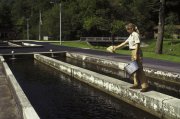|
Find Recreation Areas with FISHHATCHERY Activities |
Fish hatcheries were established in the 1800's, to enhance the number of fish in streams and lakes where native fish populations were declining due to changes in the natural environment. "Cultured" fish were used to replace fish that were lost from natural causes (drought, flood, habitat destruction) or human influences (over-harvest, pollution, habitat loss due to development and dam construction), to establish fish populations to meet specific management needs, and to provide for the creation of new and expanded recreational fisheries opportunities.
Today, fish hatcheries also provide hope for endangered fish species as well as providing research on fish disease, habitat, and the future of fish in general. Not all fish hatcheries allow recreational fishing, so call ahead to see what activities are allowed.
 |
| photo
courtesy of US
Fish and Wildlife
Service employee feeding fish at fish hatchery |
Practice
Good Stewardship of
our Hatcheries:
You can help to
take care of our hatcheries,
lakes, rivers, and
other waterways so
that others may enjoy
these areas for
years to come by practicing
some of the following
actions:
Don't
Litter... take along
a trash bag or other
receptacle
for collecting your
trash so that you can
deposit it in the
proper trash receptacle.
Use proper dumping
stations instead
of tossing refuse into
the water.
Make
sure that you use the
correct type of bait
and fishing gear permitted
in that area. There
may also be limits
on the number, size,
and kind of fish that
you can keep. Check
with your destination
ahead of time to see
what the local regulations
allow.
If you use a boat or
watercraft when fishing,
check to see what kinds
of watercraft are allowed
at the body of water
where you are going
to fish.
Pay attention to local procedures and cautions at hatcheries and for cleaning your watercraft after you leave the water so that you don't encourage the spread of non-native species, such as the Zebra Mussel, to the next body of water you may visit with your boat.
Don't
fish in areas where
it is not permitted.
These areas have been
declared "off
limits" to fishing
to protect wildlife,
vegetation, or for
your safety.
Safety
While Fishing and while
visiting Hatcheries:
If using a boat to fish, wear your life jacket and make sure that your passengers wear theirs, too !
Use caution when baiting and removing hooks
Don't kick or dislodge pebbles or other debris into the hatchery beds... these objects can harm developing fish!
Do not fish on unauthorized waterways
If operating a houseboat, be careful of carbon monoxide build-up around the boat
Obey the posted speedlimits and wake warnings if using a watercraft when fishing
Bring
along extra safety
items such as water,
flashlights, maps,
and a cellphone or
radio